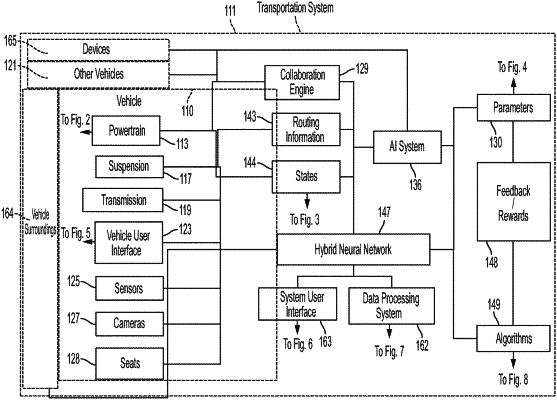| CPC G06Q 50/188 (2013.01) [B60W 40/08 (2013.01); G01C 21/3438 (2013.01); G01C 21/3469 (2013.01); G05B 13/027 (2013.01); G05D 1/0088 (2013.01); G05D 1/0212 (2013.01); G05D 1/0287 (2013.01); G06F 40/40 (2020.01); G06N 3/045 (2023.01); G06N 3/08 (2013.01); G06N 20/00 (2019.01); G06Q 50/30 (2013.01); G06V 10/764 (2022.01); G06V 10/82 (2022.01); G06V 20/56 (2022.01); G06V 20/597 (2022.01); G06V 20/64 (2022.01); G07C 5/006 (2013.01); G07C 5/008 (2013.01); G07C 5/02 (2013.01); G07C 5/08 (2013.01); G07C 5/0816 (2013.01); G07C 5/0866 (2013.01); G07C 5/0891 (2013.01); B60W 2040/0881 (2013.01); G05D 2201/0213 (2013.01); G06Q 30/0281 (2013.01); G06Q 50/01 (2013.01)] | 30 Claims |

|
1. A method of optimizing rider satisfaction, the method comprising:
classifying, using a first neural network of a hybrid neural network, keywords or phrases in social media data sourced from a plurality of social media sources as indicative of an effect on traffic congestion in a transportation system, wherein the transportation system includes a set of roadways and at least one vehicle;
predicting, using a second neural network of the hybrid neural network, a rider emotional state affected by the effect on the traffic congestion in the transportation system derived from the keywords or phrases in the social media data classified as indicative of an effect on the traffic congestion in the transportation system;
optimizing, using a third neural network of the hybrid neural network, the rider emotional state for at least one rider occupying the at least one vehicle in the transportation system, wherein the optimizing the rider emotional state for the at least one rider occupying the at least one vehicle in the transportation system includes optimizing a planned route for the at least one vehicle occupied by the at least one rider to achieve a reduced traffic congestion objective; and
communicating the planned route via an in-vehicle navigation interface to facilitate following the planned route.
|